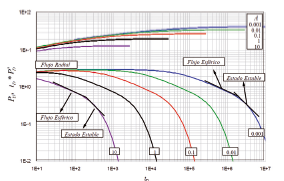Analysis of Pressure Derivate Data for Reservoirs with Top and Base Open to the Flow

Published 2019-10-15
Keywords
- Tiab’s Direct Synthesis Technique,
- pressure derivative,
- partial penetration,
- anisotropy
How to Cite
Abstract
In this paper the Tiab’s Direct Synthesis (TDS) Technique is implemented with the purpose of characterizing a reservoir with a top and base open to flow, in which a well is partially or completely completed. In order to do so, it was necessary to use a commercial software that allowed to simulate different pressure tests in a reservoir under the previously mentioned conditions, thus modifying various parameters such as anisotropy, penetration and thickness of the area of interest. From the results obtained by the software and the implementation of Tiab’s Direct Synthesis Technique, different equations are determined that allow to identify characteristic points on the pressure derivative curve for this type of reservoirs; and thus, achieving the appropriate characterization of them. The developed equations were successfully tested with synthetic examples.
Downloads
References
Buhidma, Ismail y Raghavan, Rajagopal. Transient Pressure Behavior of Partially Penetrating Wells Subject to Bottomwater Drive. JOURNAL
OF PETROLEUM TECHNOLOGY. Vol. 32, p.1261.1980. DOI: 10.2118/8143-PA.
Bourdet, Dominique. Well Test Analysis: The Use of Advanced Interpretation Models. (Handbook of petroleum exploration and production).
Amsterdam, The Netherlands, Series Editor Jhon Cubitt. Vol. 3, p. 426. 2002.
Earlougher, Robert. Advances in Well Test Analysis. American I. Dallas, Texas, United States of America. 1977. Vol. 5, p.264.
Escobar, Freddy H., Ghisays-Ruiz, Alfredo and SRIVASTAVA, Priyank. Characterization of the spherical stabilization flow regime by transient
pressure analysis. Journal of Engineering and Applied Sciences. Vol. 10. Num. 14. p. 5815-5822. August 2015.
Escobar, Freddy H., Ghisays-Ruiz, Alfredo and Hernandez, Claudia M. “Characterization of the Spherical Stabilization Flow Regime
by Transient Pressure Analysis”. Artículo TEC_100. XVII Congreso Colombiano del Petróleo y Gas 2017. Oct. 18-20, 2017. Bogotá.
Escobar, Freddy H., Bonilla, Luis F. and Hernández, Claudia M. A practical calculation of the distance to a discontinuity in anisotropic
systems from well test interpretation. DYNA ISSN 0012-7353, 85(207), pp. 65-73, Octubre- Diciembre, 2018.
Escobar, Freddy H., Zhao, Yu-Long, Urazan, Carolina and Trujillo, Cristian, M. Pressure and Pressure Derivative Interpretation for Horizontal Wells in Compressible Formations. Journal of Geophysics and Engineering. Vol. 15. pp. 1551-1560. DOI: https://doi.org/10.1088/1742-2140/
aaadc9. 2018.
Escobar, Freddy H. 2019. Novel, Integrated and Revolutionary Well Test Interpretation Analysis. Intech | Open Mind, England. 278p. DOI: http://dx.doi.org/10.5772/intechopen.81078. 2019.
Horne, Roland. Modern Well Test Analysis, A Computer-Aided Approach. Fourth Printed. Petroway, Inc. Palo Alto, CA, United States of
America.1990, p.197.
Houze, Olivier; Viturat, Didier y Fjaere, Ole. (2017) Dynamic Data Analysis (DDA). Kappa. 2017.
Streltsova, Adams. Pressure Drawdown in A Well With Limited Flow Entry. Society of Petroleum Engineer, Inc. Noviembre, 1979, p.1469–1476. DOI: https://doi.org/10.2118/7486-PA.
Streltsova, Adams. Pressure Transient Analysis for After Flow-Dominated Wells Producing from a Reservoir with A Gas Cap. Society of
Petroleum Engineer, Inc. Abril, 1981, p. 745 – 747. DOI: https://doi.org/10.2118/7979-PA.
Steward, George. Constant-pressure boundaries. En: Well Test Design and Analysis. Tulsa, Oklahoma: PennWell Corrporation. 2011, p.
439-474.
Tiab, D. Analysis of pressure and pressure derivatives without type-curve matching: I-skin and wellbore storage. Society of Petroleum
Engineer, Inc. Oklahoma City. March, 1993. DOI:10.2118/25426-MS.